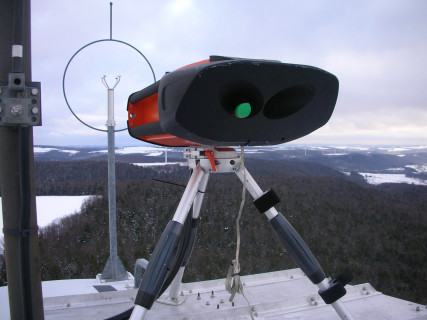January 2, 2014 | by NRG Team Voices | Engineering + Technology, Remote Sensing, Wind Plant Optimization

First Wind recently purchased a Wind Iris Lidar to optimize the performance of its wind turbines. This decision was the result of a successful field trial that used data from the nacelle-mounted Lidar to increase the total energy production of a turbine.
“We used the Wind Iris to determine whether there was yaw misalignment of one of our utility-scale wind turbines,” said Cegeon Chan, wind resource manager at First Wind.
“By detecting and accurately quantifying the yaw misalignment, we were able to correct the error and gain significant AEP improvement. Based on this evaluation, we decided to purchase a Wind Iris to optimize more turbines in our fleet.”
Curious about the results of the field trial? Read on for details:
Case Study
Customer
First Wind develops, finances, builds, and operates utility-scale renewable energy projects throughout the United States. Based in Boston, First Wind currently operates wind power facilities in the Northeast, the West, and Hawaii, with combined capacity of more than 1,000 megawatts (MW) – enough to power about 300,000 U.S. homes each year.
Objective
First Wind wanted to improve the yaw alignment of a wind turbine to maximize energy capture. Analysis of the SCADA data, including measurements from a nearby met mast and the vane measurement from the wind turbine, was not enough to determine the correction needed.
Solution
A Wind Iris was installed on a test wind turbine, and it collected wind speed and direction data ahead of the turbine for 30 days. Analysis of the data showed an average yaw error of 7 degrees. A correction factor was then applied to the yaw measurement, and 15 additional days of measurement using the Wind Iris revealed the yaw error had been eliminated (see yaw error graph).
Outcome
By using data collected with the Wind Iris to eliminate the yaw error, the annual energy production (AEP) of the wind turbine increased by 1.8%. This AEP increase was calculated with a power curve estimation model using Wind Iris data, and it was also independently verified by comparing the relative increase in turbine production with nearby control turbines that had not been optimized. While project specific revenue impacts for this case are not available, increasing AEP of a 2MW turbine by 1.8% while selling power for $60/MW-hr would have a $7,767 annual benefit.
About Wind Iris
Wind Iris is manufactured by Avent Lidar Technology, a joint venture between U.S.-based Renewable NRG Systems and France-based Leosphere. The first Lidar dedicated to turbine performance evaluation, it uses pulsed Lidar technology to measure horizontal wind speed and direction at distances of 40 to 400 meters upwind of the turbine. It has been specifically designed for repeat installations, providing the ability to rapidly optimize a wind farm.


